Reflection on NSQHS Standards in Nursing Practice
VerifiedAdded on 2022/12/26
|9
|1869
|1
AI Summary
This paper reflects on the importance of complying with the NSQHS Standards in nursing practice and the implications of violations. It discusses incidents related to hand hygiene and communication that support effective partnerships.
Contribute Materials
Your contribution can guide someone’s learning journey. Share your
documents today.
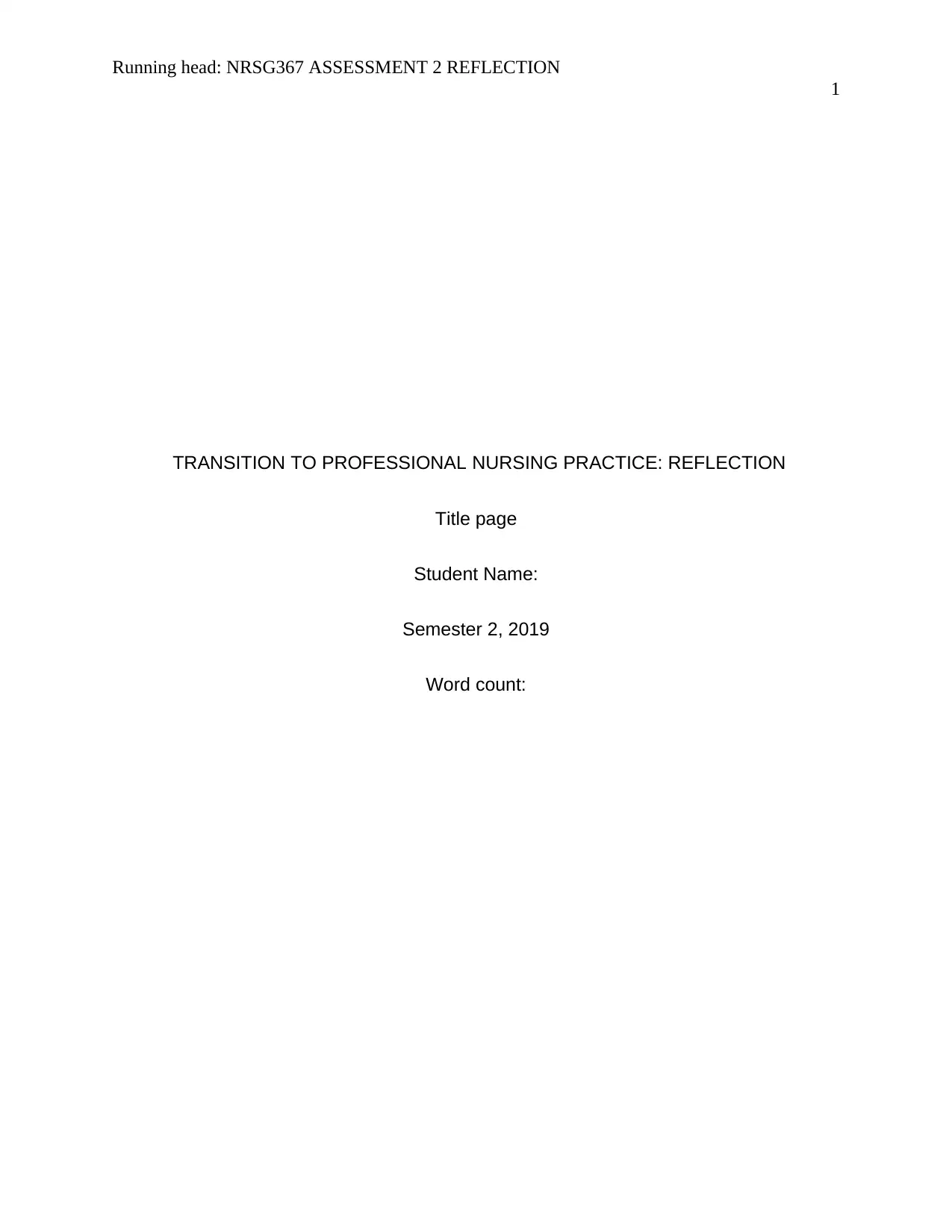
Running head: NRSG367 ASSESSMENT 2 REFLECTION
1
TRANSITION TO PROFESSIONAL NURSING PRACTICE: REFLECTION
Title page
Student Name:
Semester 2, 2019
Word count:
1
TRANSITION TO PROFESSIONAL NURSING PRACTICE: REFLECTION
Title page
Student Name:
Semester 2, 2019
Word count:
Secure Best Marks with AI Grader
Need help grading? Try our AI Grader for instant feedback on your assignments.
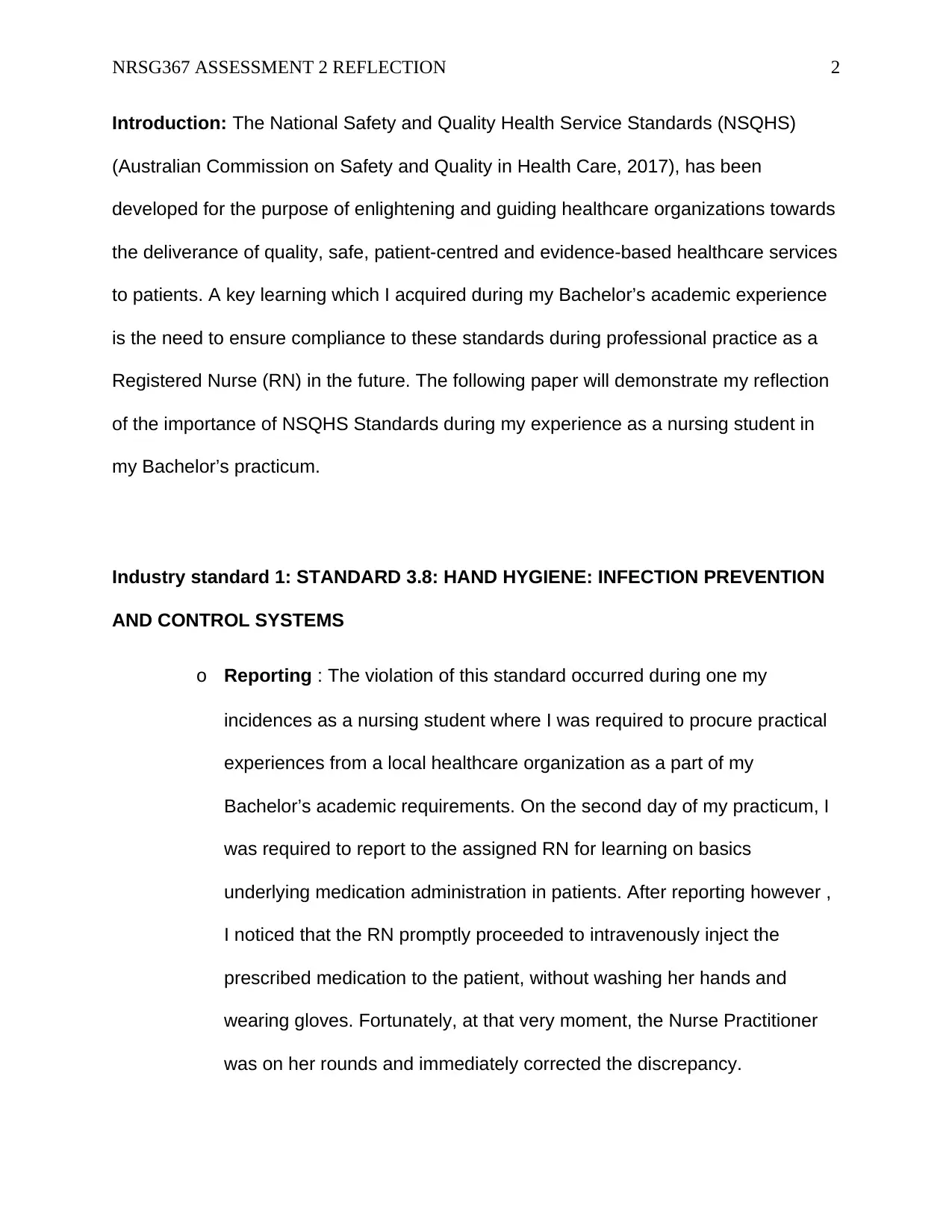
NRSG367 ASSESSMENT 2 REFLECTION 2
Introduction: The National Safety and Quality Health Service Standards (NSQHS)
(Australian Commission on Safety and Quality in Health Care, 2017), has been
developed for the purpose of enlightening and guiding healthcare organizations towards
the deliverance of quality, safe, patient-centred and evidence-based healthcare services
to patients. A key learning which I acquired during my Bachelor’s academic experience
is the need to ensure compliance to these standards during professional practice as a
Registered Nurse (RN) in the future. The following paper will demonstrate my reflection
of the importance of NSQHS Standards during my experience as a nursing student in
my Bachelor’s practicum.
Industry standard 1: STANDARD 3.8: HAND HYGIENE: INFECTION PREVENTION
AND CONTROL SYSTEMS
o Reporting : The violation of this standard occurred during one my
incidences as a nursing student where I was required to procure practical
experiences from a local healthcare organization as a part of my
Bachelor’s academic requirements. On the second day of my practicum, I
was required to report to the assigned RN for learning on basics
underlying medication administration in patients. After reporting however ,
I noticed that the RN promptly proceeded to intravenously inject the
prescribed medication to the patient, without washing her hands and
wearing gloves. Fortunately, at that very moment, the Nurse Practitioner
was on her rounds and immediately corrected the discrepancy.
Introduction: The National Safety and Quality Health Service Standards (NSQHS)
(Australian Commission on Safety and Quality in Health Care, 2017), has been
developed for the purpose of enlightening and guiding healthcare organizations towards
the deliverance of quality, safe, patient-centred and evidence-based healthcare services
to patients. A key learning which I acquired during my Bachelor’s academic experience
is the need to ensure compliance to these standards during professional practice as a
Registered Nurse (RN) in the future. The following paper will demonstrate my reflection
of the importance of NSQHS Standards during my experience as a nursing student in
my Bachelor’s practicum.
Industry standard 1: STANDARD 3.8: HAND HYGIENE: INFECTION PREVENTION
AND CONTROL SYSTEMS
o Reporting : The violation of this standard occurred during one my
incidences as a nursing student where I was required to procure practical
experiences from a local healthcare organization as a part of my
Bachelor’s academic requirements. On the second day of my practicum, I
was required to report to the assigned RN for learning on basics
underlying medication administration in patients. After reporting however ,
I noticed that the RN promptly proceeded to intravenously inject the
prescribed medication to the patient, without washing her hands and
wearing gloves. Fortunately, at that very moment, the Nurse Practitioner
was on her rounds and immediately corrected the discrepancy.

NRSG367 ASSESSMENT 2 REFLECTION 3
o Responding: I was deeply shocked and astonished to see that my
immediate supervisor, the RN, who is seemingly assumed to posses
greater healthcare literacy and awareness, engaging in such unhygienic
and unsafe patient care practices. Not only was this act of hers a serious
violation of the NSQHS Standards of Hand Hygiene (Australian
Commission on Safety and Quality in Health Care, 2017). but was also a
violation of the Nursing and Midwifery Board of Australia Standard 1 of
Practice, which dictates RNs to reflect and conduct evidence based care
(NMBA, 2016). Even though the mishap was corrected on time, the
incident provoked me to reflect on possible personal and professional
implications for my future nursing practice.
o Relating : The incident came as a significant shock to me considering that
maintenance of hand hygiene is one of the most basic considerations
which we are taught during childhood as well as during our academic
engagement in nursing. A simple act like not washing my hands on time
has led to personal experiences of illness during my childhood. Indeed,
lack of adherence to hand hygiene practices by healthcare professionals
like nurses during patient care results in adverse health consequences like
healthcare associated infections across patients which can include
patient-to-patient transmission of communicable diseases, dermal
infections or respiratory illnesses (Sickbert-Bennett et al., 2016). Thus, the
RN’s lack of adherence to such basic patient care needs not only
increases the risk of negative healthcare outcomes on patients but also
o Responding: I was deeply shocked and astonished to see that my
immediate supervisor, the RN, who is seemingly assumed to posses
greater healthcare literacy and awareness, engaging in such unhygienic
and unsafe patient care practices. Not only was this act of hers a serious
violation of the NSQHS Standards of Hand Hygiene (Australian
Commission on Safety and Quality in Health Care, 2017). but was also a
violation of the Nursing and Midwifery Board of Australia Standard 1 of
Practice, which dictates RNs to reflect and conduct evidence based care
(NMBA, 2016). Even though the mishap was corrected on time, the
incident provoked me to reflect on possible personal and professional
implications for my future nursing practice.
o Relating : The incident came as a significant shock to me considering that
maintenance of hand hygiene is one of the most basic considerations
which we are taught during childhood as well as during our academic
engagement in nursing. A simple act like not washing my hands on time
has led to personal experiences of illness during my childhood. Indeed,
lack of adherence to hand hygiene practices by healthcare professionals
like nurses during patient care results in adverse health consequences like
healthcare associated infections across patients which can include
patient-to-patient transmission of communicable diseases, dermal
infections or respiratory illnesses (Sickbert-Bennett et al., 2016). Thus, the
RN’s lack of adherence to such basic patient care needs not only
increases the risk of negative healthcare outcomes on patients but also
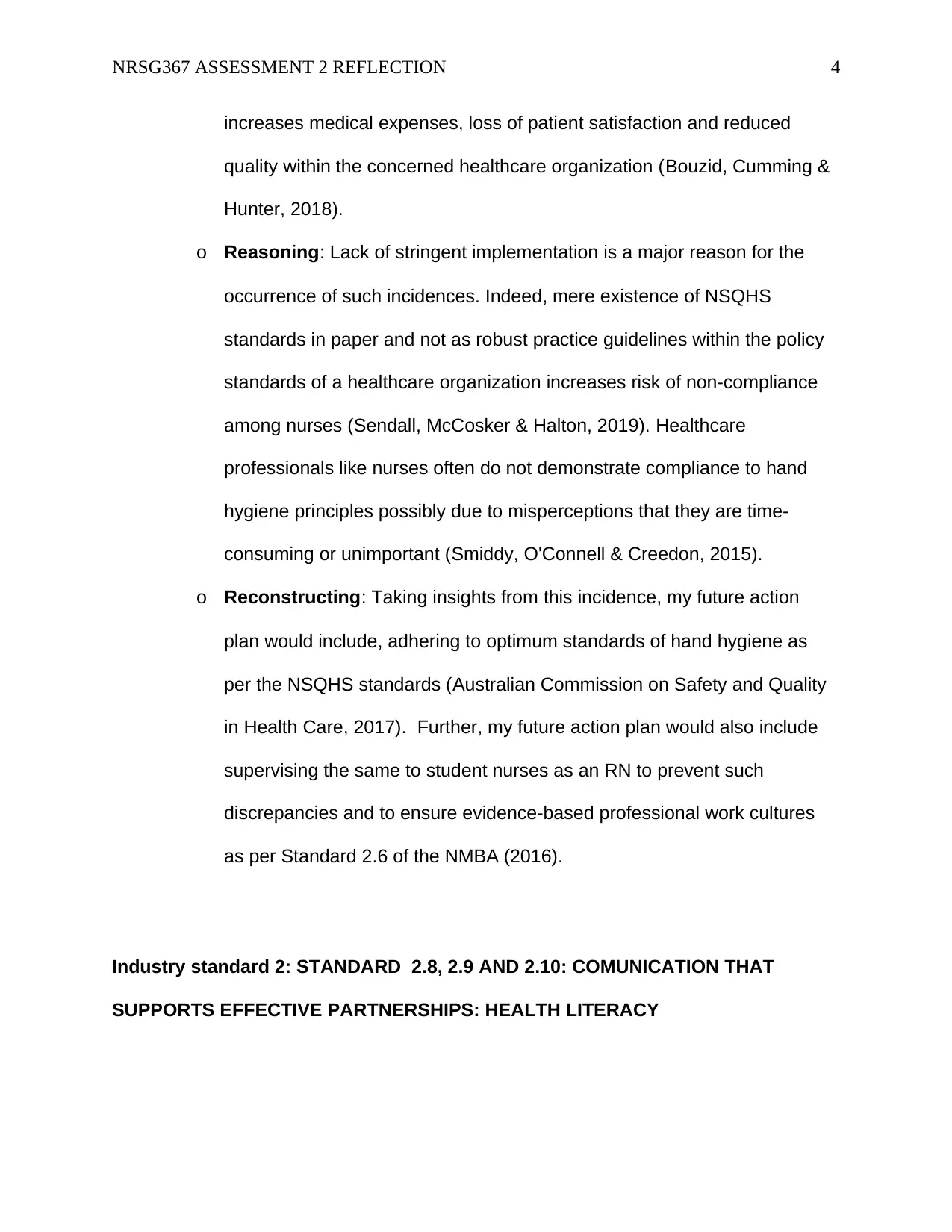
NRSG367 ASSESSMENT 2 REFLECTION 4
increases medical expenses, loss of patient satisfaction and reduced
quality within the concerned healthcare organization (Bouzid, Cumming &
Hunter, 2018).
o Reasoning: Lack of stringent implementation is a major reason for the
occurrence of such incidences. Indeed, mere existence of NSQHS
standards in paper and not as robust practice guidelines within the policy
standards of a healthcare organization increases risk of non-compliance
among nurses (Sendall, McCosker & Halton, 2019). Healthcare
professionals like nurses often do not demonstrate compliance to hand
hygiene principles possibly due to misperceptions that they are time-
consuming or unimportant (Smiddy, O'Connell & Creedon, 2015).
o Reconstructing: Taking insights from this incidence, my future action
plan would include, adhering to optimum standards of hand hygiene as
per the NSQHS standards (Australian Commission on Safety and Quality
in Health Care, 2017). Further, my future action plan would also include
supervising the same to student nurses as an RN to prevent such
discrepancies and to ensure evidence-based professional work cultures
as per Standard 2.6 of the NMBA (2016).
Industry standard 2: STANDARD 2.8, 2.9 AND 2.10: COMUNICATION THAT
SUPPORTS EFFECTIVE PARTNERSHIPS: HEALTH LITERACY
increases medical expenses, loss of patient satisfaction and reduced
quality within the concerned healthcare organization (Bouzid, Cumming &
Hunter, 2018).
o Reasoning: Lack of stringent implementation is a major reason for the
occurrence of such incidences. Indeed, mere existence of NSQHS
standards in paper and not as robust practice guidelines within the policy
standards of a healthcare organization increases risk of non-compliance
among nurses (Sendall, McCosker & Halton, 2019). Healthcare
professionals like nurses often do not demonstrate compliance to hand
hygiene principles possibly due to misperceptions that they are time-
consuming or unimportant (Smiddy, O'Connell & Creedon, 2015).
o Reconstructing: Taking insights from this incidence, my future action
plan would include, adhering to optimum standards of hand hygiene as
per the NSQHS standards (Australian Commission on Safety and Quality
in Health Care, 2017). Further, my future action plan would also include
supervising the same to student nurses as an RN to prevent such
discrepancies and to ensure evidence-based professional work cultures
as per Standard 2.6 of the NMBA (2016).
Industry standard 2: STANDARD 2.8, 2.9 AND 2.10: COMUNICATION THAT
SUPPORTS EFFECTIVE PARTNERSHIPS: HEALTH LITERACY
Secure Best Marks with AI Grader
Need help grading? Try our AI Grader for instant feedback on your assignments.
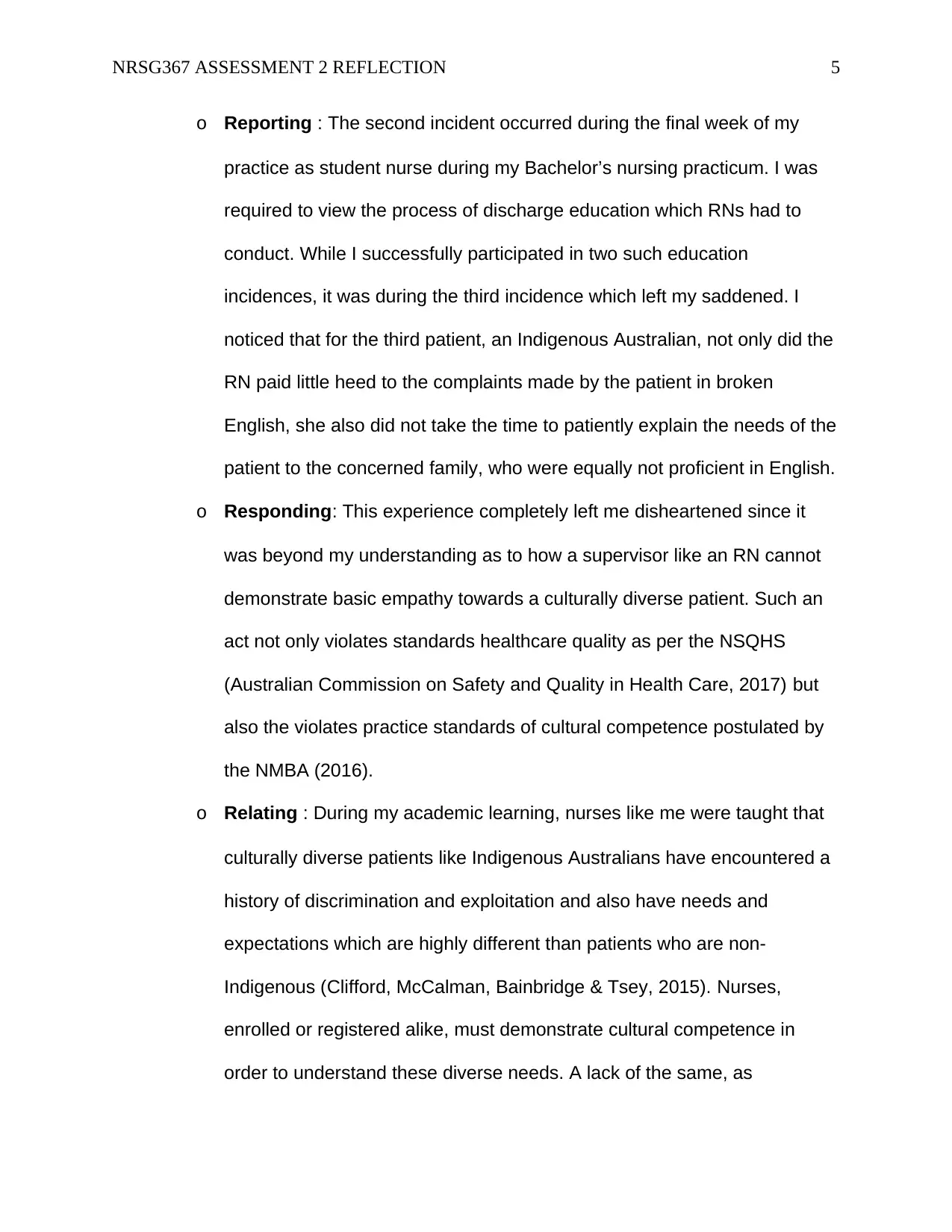
NRSG367 ASSESSMENT 2 REFLECTION 5
o Reporting : The second incident occurred during the final week of my
practice as student nurse during my Bachelor’s nursing practicum. I was
required to view the process of discharge education which RNs had to
conduct. While I successfully participated in two such education
incidences, it was during the third incidence which left my saddened. I
noticed that for the third patient, an Indigenous Australian, not only did the
RN paid little heed to the complaints made by the patient in broken
English, she also did not take the time to patiently explain the needs of the
patient to the concerned family, who were equally not proficient in English.
o Responding: This experience completely left me disheartened since it
was beyond my understanding as to how a supervisor like an RN cannot
demonstrate basic empathy towards a culturally diverse patient. Such an
act not only violates standards healthcare quality as per the NSQHS
(Australian Commission on Safety and Quality in Health Care, 2017) but
also the violates practice standards of cultural competence postulated by
the NMBA (2016).
o Relating : During my academic learning, nurses like me were taught that
culturally diverse patients like Indigenous Australians have encountered a
history of discrimination and exploitation and also have needs and
expectations which are highly different than patients who are non-
Indigenous (Clifford, McCalman, Bainbridge & Tsey, 2015). Nurses,
enrolled or registered alike, must demonstrate cultural competence in
order to understand these diverse needs. A lack of the same, as
o Reporting : The second incident occurred during the final week of my
practice as student nurse during my Bachelor’s nursing practicum. I was
required to view the process of discharge education which RNs had to
conduct. While I successfully participated in two such education
incidences, it was during the third incidence which left my saddened. I
noticed that for the third patient, an Indigenous Australian, not only did the
RN paid little heed to the complaints made by the patient in broken
English, she also did not take the time to patiently explain the needs of the
patient to the concerned family, who were equally not proficient in English.
o Responding: This experience completely left me disheartened since it
was beyond my understanding as to how a supervisor like an RN cannot
demonstrate basic empathy towards a culturally diverse patient. Such an
act not only violates standards healthcare quality as per the NSQHS
(Australian Commission on Safety and Quality in Health Care, 2017) but
also the violates practice standards of cultural competence postulated by
the NMBA (2016).
o Relating : During my academic learning, nurses like me were taught that
culturally diverse patients like Indigenous Australians have encountered a
history of discrimination and exploitation and also have needs and
expectations which are highly different than patients who are non-
Indigenous (Clifford, McCalman, Bainbridge & Tsey, 2015). Nurses,
enrolled or registered alike, must demonstrate cultural competence in
order to understand these diverse needs. A lack of the same, as
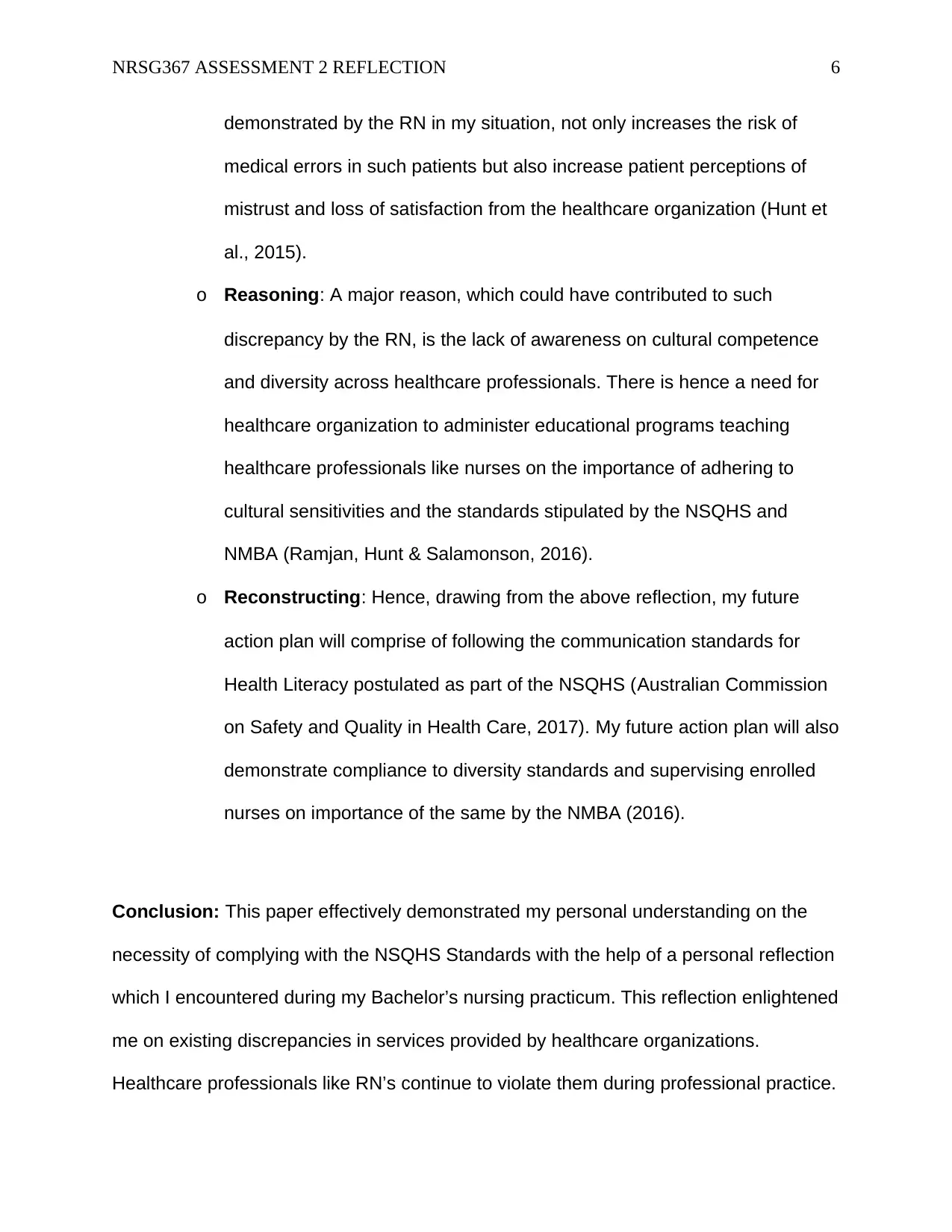
NRSG367 ASSESSMENT 2 REFLECTION 6
demonstrated by the RN in my situation, not only increases the risk of
medical errors in such patients but also increase patient perceptions of
mistrust and loss of satisfaction from the healthcare organization (Hunt et
al., 2015).
o Reasoning: A major reason, which could have contributed to such
discrepancy by the RN, is the lack of awareness on cultural competence
and diversity across healthcare professionals. There is hence a need for
healthcare organization to administer educational programs teaching
healthcare professionals like nurses on the importance of adhering to
cultural sensitivities and the standards stipulated by the NSQHS and
NMBA (Ramjan, Hunt & Salamonson, 2016).
o Reconstructing: Hence, drawing from the above reflection, my future
action plan will comprise of following the communication standards for
Health Literacy postulated as part of the NSQHS (Australian Commission
on Safety and Quality in Health Care, 2017). My future action plan will also
demonstrate compliance to diversity standards and supervising enrolled
nurses on importance of the same by the NMBA (2016).
Conclusion: This paper effectively demonstrated my personal understanding on the
necessity of complying with the NSQHS Standards with the help of a personal reflection
which I encountered during my Bachelor’s nursing practicum. This reflection enlightened
me on existing discrepancies in services provided by healthcare organizations.
Healthcare professionals like RN’s continue to violate them during professional practice.
demonstrated by the RN in my situation, not only increases the risk of
medical errors in such patients but also increase patient perceptions of
mistrust and loss of satisfaction from the healthcare organization (Hunt et
al., 2015).
o Reasoning: A major reason, which could have contributed to such
discrepancy by the RN, is the lack of awareness on cultural competence
and diversity across healthcare professionals. There is hence a need for
healthcare organization to administer educational programs teaching
healthcare professionals like nurses on the importance of adhering to
cultural sensitivities and the standards stipulated by the NSQHS and
NMBA (Ramjan, Hunt & Salamonson, 2016).
o Reconstructing: Hence, drawing from the above reflection, my future
action plan will comprise of following the communication standards for
Health Literacy postulated as part of the NSQHS (Australian Commission
on Safety and Quality in Health Care, 2017). My future action plan will also
demonstrate compliance to diversity standards and supervising enrolled
nurses on importance of the same by the NMBA (2016).
Conclusion: This paper effectively demonstrated my personal understanding on the
necessity of complying with the NSQHS Standards with the help of a personal reflection
which I encountered during my Bachelor’s nursing practicum. This reflection enlightened
me on existing discrepancies in services provided by healthcare organizations.
Healthcare professionals like RN’s continue to violate them during professional practice.
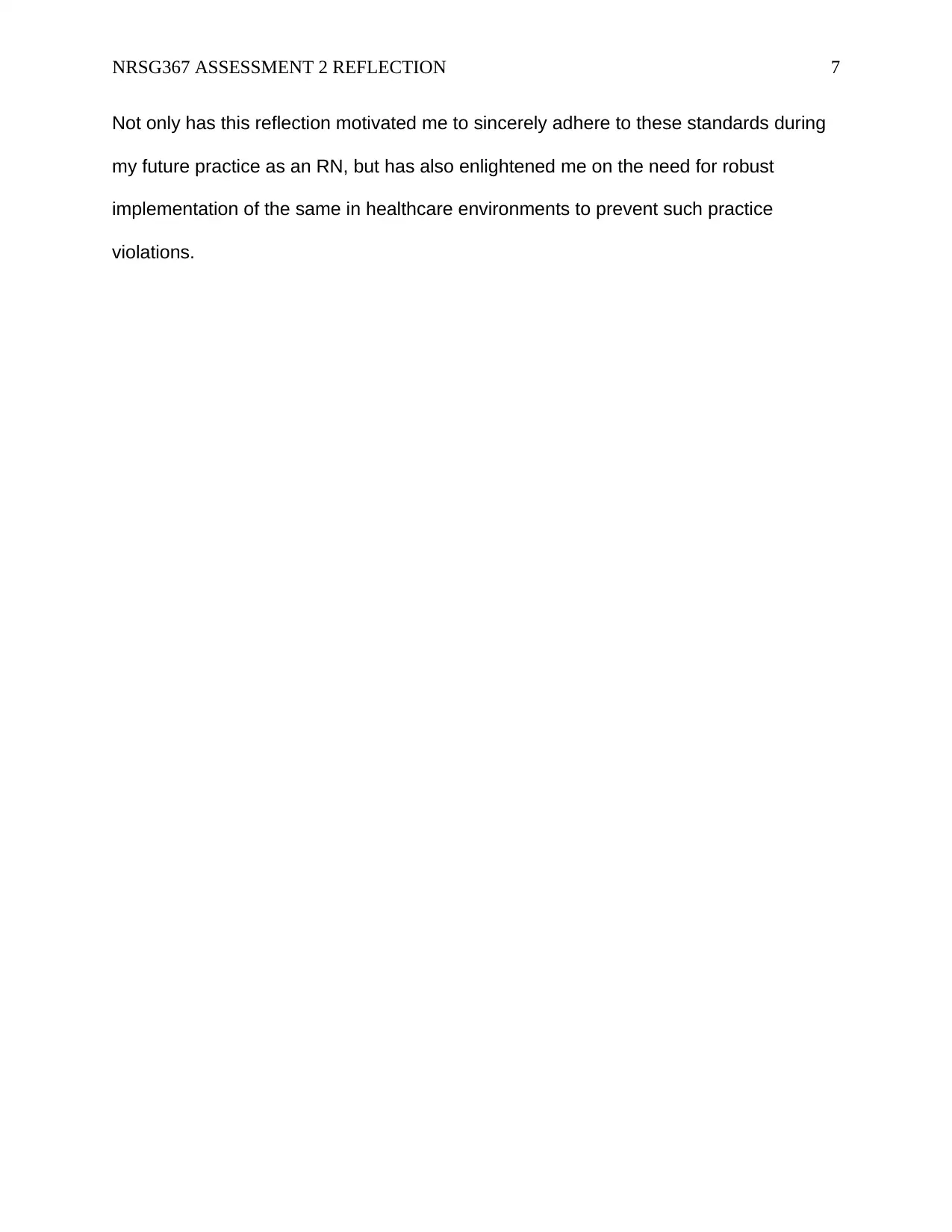
NRSG367 ASSESSMENT 2 REFLECTION 7
Not only has this reflection motivated me to sincerely adhere to these standards during
my future practice as an RN, but has also enlightened me on the need for robust
implementation of the same in healthcare environments to prevent such practice
violations.
Not only has this reflection motivated me to sincerely adhere to these standards during
my future practice as an RN, but has also enlightened me on the need for robust
implementation of the same in healthcare environments to prevent such practice
violations.
Paraphrase This Document
Need a fresh take? Get an instant paraphrase of this document with our AI Paraphraser

NRSG367 ASSESSMENT 2 REFLECTION 8
References
Australian Commission on Safety and Quality in Health Care. (2017). National Safety
and Quality Health Service Standards (2nd ed.). Sydney: ACSQHC.
Retrieved from https://www.safetyandquality.gov.au/sites/default/files/2019-
04/National-Safety-and-Quality-Health-Service-Standardssecond-
edition.pdf.
Bouzid, M., Cumming, O., & Hunter, P. R. (2018). What is the impact of water sanitation
and hygiene in healthcare facilities on care seeking behaviour and patient
satisfaction? A systematic review of the evidence from low-income and
middle-income countries. BMJ global health, 3(3), e000648. doi:
http://dx.doi.org/10.1136/bmjgh-2017-000648.
Clifford, A., McCalman, J., Bainbridge, R., & Tsey, K. (2015). Interventions to improve
cultural competency in health care for Indigenous peoples of Australia, New
Zealand, Canada and the USA: a systematic review. International Journal
for Quality in Health Care, 27(2), 89-98. doi:
https://doi.org/10.1093/intqhc/mzv010.
Hunt, L., Ramjan, L., McDonald, G., Koch, J., Baird, D., & Salamonson, Y. (2015).
Nursing students' perspectives of the health and healthcare issues of
Australian Indigenous people. Nurse education today, 35(3), 461-467. doi:
https://doi.org/10.1016/j.nedt.2014.11.019.
NMBA. (2016). Nursing and Midwifery Board of Australia - Professional standards.
Retrieved 30 August 2019, from
https://www.nursingmidwiferyboard.gov.au/Codes-Guidelines-Statements/
References
Australian Commission on Safety and Quality in Health Care. (2017). National Safety
and Quality Health Service Standards (2nd ed.). Sydney: ACSQHC.
Retrieved from https://www.safetyandquality.gov.au/sites/default/files/2019-
04/National-Safety-and-Quality-Health-Service-Standardssecond-
edition.pdf.
Bouzid, M., Cumming, O., & Hunter, P. R. (2018). What is the impact of water sanitation
and hygiene in healthcare facilities on care seeking behaviour and patient
satisfaction? A systematic review of the evidence from low-income and
middle-income countries. BMJ global health, 3(3), e000648. doi:
http://dx.doi.org/10.1136/bmjgh-2017-000648.
Clifford, A., McCalman, J., Bainbridge, R., & Tsey, K. (2015). Interventions to improve
cultural competency in health care for Indigenous peoples of Australia, New
Zealand, Canada and the USA: a systematic review. International Journal
for Quality in Health Care, 27(2), 89-98. doi:
https://doi.org/10.1093/intqhc/mzv010.
Hunt, L., Ramjan, L., McDonald, G., Koch, J., Baird, D., & Salamonson, Y. (2015).
Nursing students' perspectives of the health and healthcare issues of
Australian Indigenous people. Nurse education today, 35(3), 461-467. doi:
https://doi.org/10.1016/j.nedt.2014.11.019.
NMBA. (2016). Nursing and Midwifery Board of Australia - Professional standards.
Retrieved 30 August 2019, from
https://www.nursingmidwiferyboard.gov.au/Codes-Guidelines-Statements/
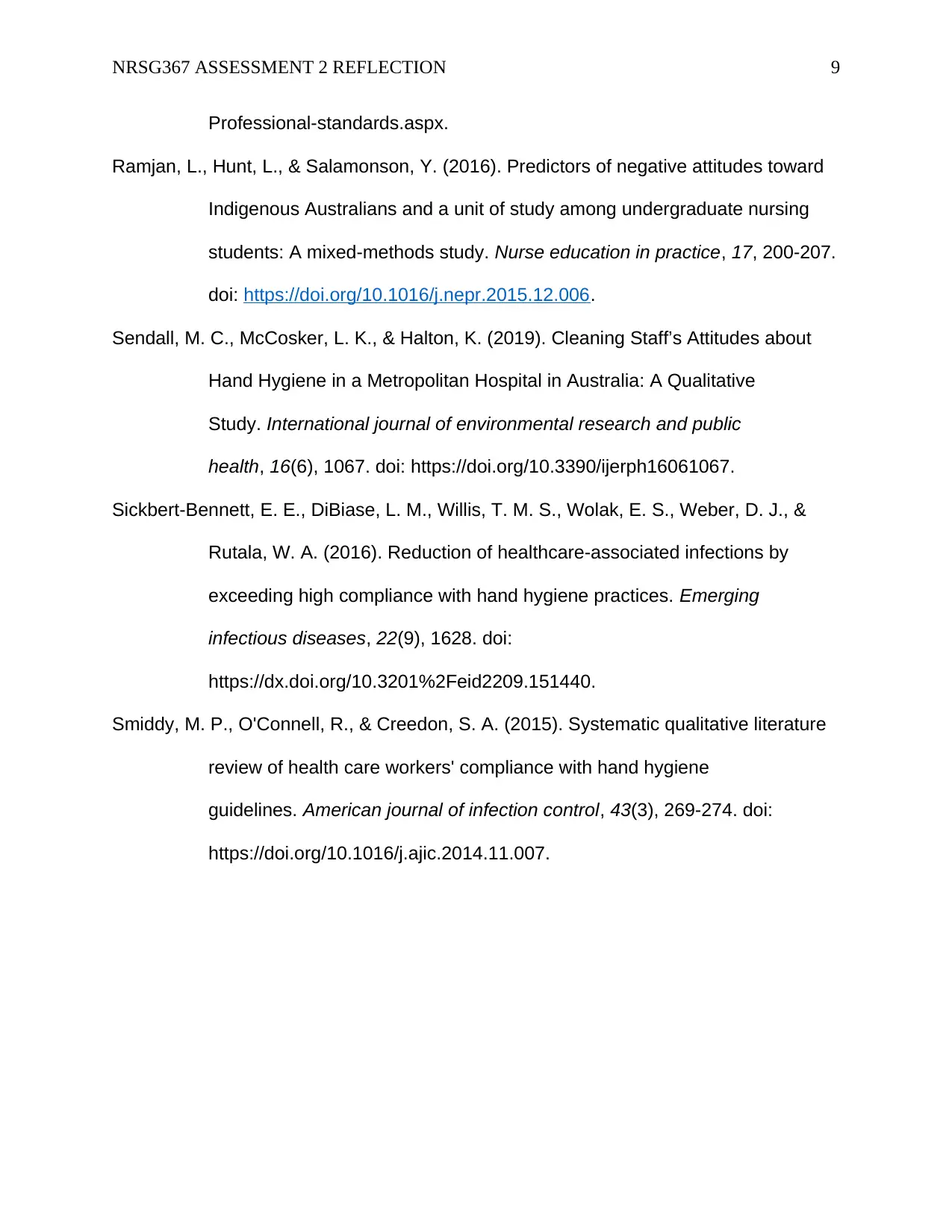
NRSG367 ASSESSMENT 2 REFLECTION 9
Professional-standards.aspx.
Ramjan, L., Hunt, L., & Salamonson, Y. (2016). Predictors of negative attitudes toward
Indigenous Australians and a unit of study among undergraduate nursing
students: A mixed-methods study. Nurse education in practice, 17, 200-207.
doi: https://doi.org/10.1016/j.nepr.2015.12.006.
Sendall, M. C., McCosker, L. K., & Halton, K. (2019). Cleaning Staff’s Attitudes about
Hand Hygiene in a Metropolitan Hospital in Australia: A Qualitative
Study. International journal of environmental research and public
health, 16(6), 1067. doi: https://doi.org/10.3390/ijerph16061067.
Sickbert-Bennett, E. E., DiBiase, L. M., Willis, T. M. S., Wolak, E. S., Weber, D. J., &
Rutala, W. A. (2016). Reduction of healthcare-associated infections by
exceeding high compliance with hand hygiene practices. Emerging
infectious diseases, 22(9), 1628. doi:
https://dx.doi.org/10.3201%2Feid2209.151440.
Smiddy, M. P., O'Connell, R., & Creedon, S. A. (2015). Systematic qualitative literature
review of health care workers' compliance with hand hygiene
guidelines. American journal of infection control, 43(3), 269-274. doi:
https://doi.org/10.1016/j.ajic.2014.11.007.
Professional-standards.aspx.
Ramjan, L., Hunt, L., & Salamonson, Y. (2016). Predictors of negative attitudes toward
Indigenous Australians and a unit of study among undergraduate nursing
students: A mixed-methods study. Nurse education in practice, 17, 200-207.
doi: https://doi.org/10.1016/j.nepr.2015.12.006.
Sendall, M. C., McCosker, L. K., & Halton, K. (2019). Cleaning Staff’s Attitudes about
Hand Hygiene in a Metropolitan Hospital in Australia: A Qualitative
Study. International journal of environmental research and public
health, 16(6), 1067. doi: https://doi.org/10.3390/ijerph16061067.
Sickbert-Bennett, E. E., DiBiase, L. M., Willis, T. M. S., Wolak, E. S., Weber, D. J., &
Rutala, W. A. (2016). Reduction of healthcare-associated infections by
exceeding high compliance with hand hygiene practices. Emerging
infectious diseases, 22(9), 1628. doi:
https://dx.doi.org/10.3201%2Feid2209.151440.
Smiddy, M. P., O'Connell, R., & Creedon, S. A. (2015). Systematic qualitative literature
review of health care workers' compliance with hand hygiene
guidelines. American journal of infection control, 43(3), 269-274. doi:
https://doi.org/10.1016/j.ajic.2014.11.007.
1 out of 9
Related Documents
Your All-in-One AI-Powered Toolkit for Academic Success.
+13062052269
info@desklib.com
Available 24*7 on WhatsApp / Email
![[object Object]](/_next/static/media/star-bottom.7253800d.svg)
Unlock your academic potential
© 2024 | Zucol Services PVT LTD | All rights reserved.





